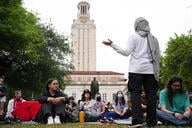You have /5 articles left.
Sign up for a free account or log in.

Students largely don’t mind the idea of employees in departments across campus working remotely.
Artis777/iStock/Getty Images Plus
What is the future of higher ed?
What is the future of work in the U.S.?
What is the future of work within higher ed?
College and university officials are grappling with big questions like these, “trying to figure out what our new reality looks like,” says Jay Stephens, vice president for human capital services at Kansas State University and chair of the executive committee of CUPA-HR, the association of college and university human resources leaders.
Although many campus departments managed to function fully remotely during the unprecedented medical emergency in spring 2020, “now we’re mainly sort of in this post-COVID period,” Stephens says. An estimated 60 to 70 percent of his unit’s employees are hybrid or fully remote now; “pre-COVID, that was zero. We didn’t even think about it.”
As institutional teams mull over how best to navigate current and prospective employees’ desires for flexibility in work location and hours, there seems to be agreement that student needs should be central to decision-making about departments and individual employees.
[block:block=176]
Even with positions that have heavy student contact, however, must those services be delivered in person? That’s a question Andy Brantley, president and CEO of CUPA-HR, says college and university and department leaders are discussing based on data they’re collecting on student interactions. “Some virtual presence might be effective, or more effective. It’s not about just putting one department in a bucket and saying, ‘Yes, all these need to be delivered in person.’” Officials are weighing the impact of such balancing act decisions in the context of campus culture and the mission of the institution.
Jeff Herring, chief human resources officer at the University of Utah, says this discussion has been “top of the list in HR” for the last two years. At first, some people thought things would return to pre-COVID normal after the pandemic. “I’m not sure that’s even an option. We’ve got to be creative in how we find the solution to dealing with the situation, while providing new flexibility that the workforce is demanding,” explains Herring, also past chair of CUPA-HR’s executive committee. About 55 percent of the university’s workforce of 25,000 employees (excluding those at the hospitals) currently have a hybrid work status, and 15 percent are fully remote.
The latest Student Voice survey, conducted in mid-July and capturing the experiences and opinions of 2,239 college undergrads and spring 2022 graduates, asked about experiences with non-academic campus offices, including comfort levels with fully remote departments. Findings of the survey, from Inside Higher Ed and College Pulse with support from Kaplan, indicate that many students don’t see in-person staffing as necessary.
- Students are most likely to say the counseling center and the financial aid office will always need to have some staff on campus for students to interact with in person, but even these top responses only got selected by 56 percent of respondents.
- Students are least likely to believe the athletics department and event ticketing must have in-person staff, with that department selected by 20 percent of respondents. One in four say the bursar/student accounts office must have an in-person presence, and one in three named the registrar or the career center.
- Twelve percent of students don’t believe any of the 12 departments listed would need to have some staff working on campus. First-year and second-year students are less likely than students who just graduated to value offices having in-person employees available.
As campus conversations about the remote and hybrid work arrangement policies and practice continue, what role does student opinion on the matter play? It’s a question without a firm answer.
Student Perceptions—and Misperceptions
The Student Voice survey findings about employee whereabouts, in the opinion of some in higher ed, may need an asterisk to provide more context.
“I don’t think students fully understand the services available to them,” says Joshua Sine, who spent 15 years as a higher ed administrator and is now vice president of higher education strategy at Qualtrics, an experience-management software company.
Take residence life, for example, which only four in 10 students says needs in-person employees. Perhaps students aren’t concerned about a physical central housing office because residential advisers and other employees assigned to residence halls are there in person.
“I think if we didn’t have the staff, they would certainly notice,” says Suzanne Price, assistant vice president for auxiliary enterprises at Clemson University, who also serves on the executive board at ACUHO-I, the Association of College and University Housing Officers–International. “Things don’t always run as smoothly as we would like, but there’s a lot of behind-the-scenes work from housing and res life staff that our students know nothing about.” (It’s not a big issue, she adds, because students should be focused on having a great experience and not all that the college does to help with that.)
Or, consider the mail room, which only 35 percent of respondents say must have in-person staff. The introduction of campus locker systems and package delivery supports late-night and after-hours mail services, says DJ Pepito, chief learning officer at NACAS, the association that supports nonacademic departments. She suspects a misperception of how such systems work. “Students think this package magically appears.”
Although about equal numbers of respondents who were in college pre-COVID say service levels are now better than before or say service levels are now worse than before, in Sine’s “anecdotal and professional opinion, the service level during COVID in general dropped significantly.” However, he believes expectations about service changed and students are now more understanding. In early COVID, students interacted with remote staff who may have had kids jumping into their laps during a meeting, and now they seem more apathetic about service interactions.
Still, some survey respondents made it clear in their comments that in-person interactions are best. A student at an Illinois community college even expressed the belief that people give misinformation on purpose in virtual interactions. “Online we tend to talk more falsely about information, but in person you are face-to-face, so you will tell the truth.”
Lauren O’Donnell, who just began her senior year at Wichita State University, says making a phone call can seem “more stressful to a student than just walking in and asking someone at a desk.” In addition, with strong feelings like anger, seeing someone in person will likely be more effective. “That emotion is sort of lost in translation with email or chat, or even phone calls,” she says.
In terms of ensuring a single individual is in campus offices at all times to assist walk-ins, O’Donnell sees this as potentially problematic. “If one person is in the office and everyone else is remote, it can get a lot more frustrating for students,” such as when the staff member needs assistance from a colleague to help the student and can’t reach that person immediately.
In complex situations, students may not know what questions to ask, and solving their problem could be easier with a live person, as opposed to a chat bot on the department’s webpage or an email, says Melanie Gottlieb, deputy director of the American Association of Collegiate Registrars and Admissions Officers. “They think they have a particular problem, and that in-person engagement with a professional teases out what the actual problem is.” However, meeting over Zoom, now that everyone is used to it, can be just as effective, she adds.
Clearly worded and comprehensive department webpages can help answer common questions and direct students to the right person when help is needed. Four in 10 survey respondents are aware of at least one campus department with an FAQ, and one in five students would like to see FAQs on more department sites. Thirty-six percent, meanwhile, would like to see more sites with AI-powered chat bots to help answer questions outside business hours.
When asked about difficulties in determining when or how to connect with any of 18 campus offices named in the survey, students were most likely to choose financial aid as not making this key information clear.
Remote campus employees can also make student work-study experiences more challenging. When O’Donnell worked at Wichita State’s rec center, she frequently needed to check in with full-time staff to assist students. If those colleagues weren’t physically there, she wouldn’t be able to say, “Let me go grab them,” or “let me talk to them.”
In addition, she can envision it being difficult for student workers to get to know their supervisors and colleagues who may be working remotely.
Pepito, who points out that many auxiliary services departments rely heavily on student workers, says supervisors must consider both how professionals want to work and how students in their offices want to work, including interacting with colleagues and forming a community within a department.
Staffing and Waiting
Staffing shortages are one reason for colleges, as employers, to consider allowing hybrid or fully remote work. Discussions must “include the reality of the world that we live in right now and challenges in recruiting, retaining and engaging staff,” says Brantley, adding that job ads leaving out the detail of whether the position is in person, hybrid or remote creates recruitment problems.
According to CUPA-HR higher ed workforce surveys, in 2021–22 the turnover rate for full-time exempt staff was 15 percent, and for full-time nonexempt staff it was 17 percent.
“Higher ed, like everywhere, has just been through the wringer,” says Stephens at Kansas State. His campus has experienced a really hard time with turnover and bad hiring pools in the past eight or nine months, although he says the situation seems to be shifting and the quality of hiring pools is at least getting better.
Short-staffed departments contribute to students not getting answers about inquiries in as timely a manner as they’d like. As one student at a Georgia public university noted, the biggest service-related headache has been “the hold!! It’s always so long to get someone and by then they’re in a bad mood and I hate it.”
Justin Draeger, president and CEO of the National Association of Student Financial Aid Administrators, says he can understand the frustration students feel with needing to wait for help from employees in a campus office. “Waiting in any scenario in this day and age is tough, particularly when it’s something that impacts your immediate and long-term future, like financial aid.”
Student Voice respondents have generally had good experiences with not having to wait long for help in person or on the phone, with about half never having had to wait more than 15 minutes in either situation. A little more than half of respondents know of departments with virtual appointment scheduling, and about one in four is aware of the use of queuing systems, in person or virtual.
Reimagining Work on Campus
At the University of Utah, officials formed a cross-functional group—including HR, finance, student affairs, parking and environmental quality groups, among others—to discuss post-pandemic realities and policy related to where and when employees work. A telecommuting-focused site called Work Reimagined launched in spring 2021, featuring campus forms and resources, FAQs for employees and supervisors, and a handful of training courses for each group.
The program is based on principles developed about remote work, including that individual managers could make telecommuting decisions, with encouragement to try to find a balance between the best interests of the university and individual employee desires.
“We wanted it to be equitable, but that does not mean equal,” says Herring of the fact that some individuals’ duties and job requirements would not allow for remote work. “We cannot mow the lawn remotely yet,” he points out.
And for supervisors who approve such arrangements, the university aims to support them with training on topics such as managing a virtual workforce, keeping virtual teams productive and building trust in a virtual work environment.
Kansas State also leaves decisions about employee arrangements up to managers, as part of a summer 2021 revision of its remote work policy. “I’m not in the business of telling student affairs how to run their office,” for example, says Stephens. “They know what they’re doing; they know how to take care of their students. This is just another level of learning for leaders and managers as supervisors.”
The policy includes guidance on how to analyze individuals and their roles to see if they are a match for hybrid or fully remote work. That option can help keep employees satisfied. “It’s not the answer to the Great Resignation, but it’s a tool you can use,” Stephens says.
Many institutions have been, and still are, struggling to envision the right balance of in-person, hybrid and remote staffing, says Brantley. “From my conversations with HR leaders, policies and general guidelines are being developed centrally, but a lot are dispersing that [decision-making power] to departments.”
Even those who decided to mandate a full-time, in-person return for all employees are still in discussion about the future, as pressure to create more hybrid and flexible work options builds, he adds. “Everything is still very much a work in progress, and the best policies implemented right now have the caveat that ‘the world is continuing to change and we are continuing to adapt our policies and procedures to benefit our institutions and students long term.’”
Brantley reminds those at colleges who are committed to in-person delivery of every aspect of the student experience that “just because it’s delivered in person doesn’t mean the student is having a positive experience.” Ensuring that staff members are adequately equipped to respond to requests is more important than ensuring interactions are in person.
Managers who dig their heels in about in-person requirements may find themselves stuck in the mud alone.
Herring recently had a senior administrator complain about another department taking all his people. Can’t we just, as a university, say everyone must be back? the person wondered. If that were to happen, Herring replied, employees would just be leaving the university instead of leaving the unit.
Still, he adds, “We don’t let workforce demand dictate the student experience. The student experience has got to be paramount.”
Philip Hunt, who joined North Dakota State University as registrar just a few months into the pandemic, has heard rumblings from people who feel they successfully did their jobs during campus shutdowns and should be able to continue with hybrid arrangements. “I don’t think the mass exodus is over,” he says. “Unless institutions are able to address this issue, it’s only going to get worse.”
Benefits to Students, the Institution
Some colleges and universities strategically use flexible work location desires to allow departments to better serve students, such as by stretching the typical business hours around student need, says Sine from Qualtrics. “Nine-to-five doesn’t work anymore.” Students taking hybrid courses might not be able to get to campus, or an office might need to be open in the evening to support adult students. “Expectations have changed, and the new normal can’t just be a diluted version of the old normal.”
 And, as Herring notes, some employees prefer to work in the evenings anyway.
And, as Herring notes, some employees prefer to work in the evenings anyway.
His institution has taken COVID-created flexibility and turned it into an opportunity to extend its brand to remote parts of Utah. Allowing some jobs to be fully remote enables the institution to be involved in economic development across the state, with the added benefit of enticing talent from rural areas to apply for positions, he says.
On campus, flexibility in employee whereabouts is having a positive impact in some less expected areas—such as more parking spots available to students, reduction in carbon footprint and the ability to more strategically allocate space, says Herring.
As for a concern that Mondays and Fridays would become too sparse with staffing, he adds, that hasn’t happened. “When you have 70 percent of staff on campus, it still feels pretty populated.”
Read more about the Student Voice survey on interactions with campus offices and how students feel about the service being received.




